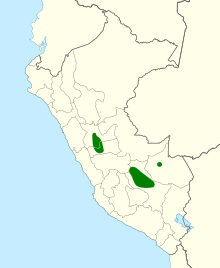| Green-and-white hummingbird | |
|---|---|

| |
| Conservation status | |
 Least Concern (IUCN 3.1) | |
| CITES Appendix II (CITES) | |
| Scientific classification | |
| Domain: | Eukaryota |
| Kingdom: | Animalia |
| Phylum: | Chordata |
| Class: | Aves |
| Clade: | Strisores |
| Order: | Apodiformes |
| Family: | Trochilidae |
| Genus: | Elliotomyia |
| Species: | E. viridicauda |
| Binomial name | |
| Elliotomyia viridicauda (von Berlepsch, 1883) | |

| |
| Synonyms | |
| |
The green-and-white hummingbird (Elliotomyia viridicauda) is a species of hummingbird in the "emeralds", tribe Trochilini of subfamily Trochilinae. It is endemic to Peru.
Taxonomy and systematics
The green-and-white hummingbird has at various times been placed in genera Leucippus and Elliotia, and until 2014 in Amazilia. A molecular phylogenetic study published in 2014 found that Amazilia was polyphyletic. In the revised classification to create monophyletic genera, the green-and-white hummingbird was placed by most taxonomic systems in a new genus Elliotomyia. However, BirdLife International's Handbook of the Birds of the World (HBW) retains it in Amazilia.
The green-and-white hummingbird shares genus Elliotomyia with the white-bellied hummingbird (E. chionogaster). It is monotypic.
Description
The green-and-white hummingbird is 10 to 11 cm (3.9 to 4.3 in) long. Males weigh about 6.0 g (0.21 oz) and females about 5.5 g (0.19 oz). Both sexes have a medium length straight bill with a blackish maxilla and a reddish mandible with a dark tip. Adult males have brilliant green to bronze-green upperparts and flanks. Their undersides are whitish from the chin to the undertail coverts with greenish spots on the sides of the chin and throat and sometimes some golden-green on the coverts. Their tail is grayish green to golden green. Adult females are very similar to males, but with a light cream chin and throat that are more heavily spotted. Juveniles are similar to adult females with the cream of the throat extending to the belly.
Distribution and habitat
The green-and-white hummingbird is found on the east slope of the Peruvian Andes discontinuously from Huánuco Department south to Cuzco, including at Machu Picchu. It inhabits the edges and clearings of mature subtropical forest and also secondary forest between the elevations of 1,000 and 2,500 m (3,300 and 8,200 ft).
Behavior
Movement
The green-and-white hummingbird is generally sedentary though some local dispersal is probable.
Feeding
The white-bellied hummingbird forages for nectar at a variety of flowering plants, shrubs, and trees, though its diet is not known in detail. In addition to nectar it feeds on small arthropods.
Breeding
The white-bellied hummingbird's full breeding season has not been determined, but it is known to include January. It makes a cup nest of plant wool bound by spiderweb with lichen on the outside, and often places it on a horizontal branch of a small tree. The incubation period and time to fledging are not known.
|
Songs and calls Listen to green-and-white hummingbird on xeno-canto |
Vocalization
The green-and-white hummingbird's song is "a repeated short phrase of typically three squeaky notes, 'tseet-chew-chip … tseet-chew-chip ...'." Its call is "two rising high-pitched notes followed by a descending stuttering series, 'tsee-tseeet-tsi-tsi-tsi-tsi'." Both are very similar to those of its close relative the white-bellied hummingbird.
Status
The IUCN has assessed the green-and-white hummingbird as being of Least Concern, though its population size and trend are unknown. No immediate threats have been identified. It has a restricted range but is fairly common in Pasco Department and the Machu Picchu area. "urther field studies are needed to clarify the type of conservation measures required for this species."
References
- ^ BirdLife International (2016). "Green-and-white Hummingbird Amazilia viridicauda". IUCN Red List of Threatened Species. 2016. Retrieved 22 September 2022.
- "Appendices | CITES". cites.org. Retrieved 2022-01-14.
- ^ Remsen, J. V., Jr., J. I. Areta, E. Bonaccorso, S. Claramunt, A. Jaramillo, D. F. Lane, J. F. Pacheco, M. B. Robbins, F. G. Stiles, and K. J. Zimmer. Version 24 July 2022. A classification of the bird species of South America. American Ornithological Society. https://www.museum.lsu.edu/~Remsen/SACCBaseline.htm retrieved July 24, 2022
- ^ Gill, F.; Donsker, D.; Rasmussen, P., eds. (August 2022). "Hummingbirds". IOC World Bird List. v 12.2. Retrieved August 9, 2022.
- ^ HBW and BirdLife International (2021) Handbook of the Birds of the World and BirdLife International digital checklist of the birds of the world. Version 6. Available at: http://datazone.birdlife.org/userfiles/file/Species/Taxonomy/HBW-BirdLife_Checklist_v6_Dec21.zip retrieved August 7, 2022
- McGuire, J.; Witt, C.; Remsen, J.V.; Corl, A.; Rabosky, D.; Altshuler, D.; Dudley, R. (2014). "Molecular phylogenetics and the diversification of hummingbirds". Current Biology. 24 (8): 910–916. doi:10.1016/j.cub.2014.03.016. PMID 24704078.
- Stiles, F.G.; Remsen, J.V. Jr.; Mcguire, J.A. (2017). "The generic classification of the Trochilini (Aves: Trochilidae): reconciling taxonomy with phylogeny". Zootaxa. 4353 (3): 401–424. doi:10.11646/zootaxa.4353.3. PMID 29245495.
- Stiles, F. Gary; Remsen, J.V. Jr (2019). "The generic nomenclature of the Trochilini: a correction". Zootaxa. 4691 (2): 195–196. doi:10.11646/zootaxa.4691.2.10. PMID 31719409.
- Clements, J. F., T. S. Schulenberg, M. J. Iliff, S. M. Billerman, T. A. Fredericks, J. A. Gerbracht, D. Lepage, B. L. Sullivan, and C. L. Wood. 2021. The eBird/Clements checklist of Birds of the World: v2021. Downloaded from https://www.birds.cornell.edu/clementschecklist/download/ Retrieved August 25, 2021
- ^ Weller, A.A. and P. F. D. Boesman (2021). Green-and-white Hummingbird (Elliotomyia viridicauda), version 1.1. In Birds of the World (J. del Hoyo, A. Elliott, J. Sargatal, D. A. Christie, and E. de Juana, Editors). Cornell Lab of Ornithology, Ithaca, NY, USA. https://doi.org/10.2173/bow.gawhum1.01.1 retrieved September 22, 2022
